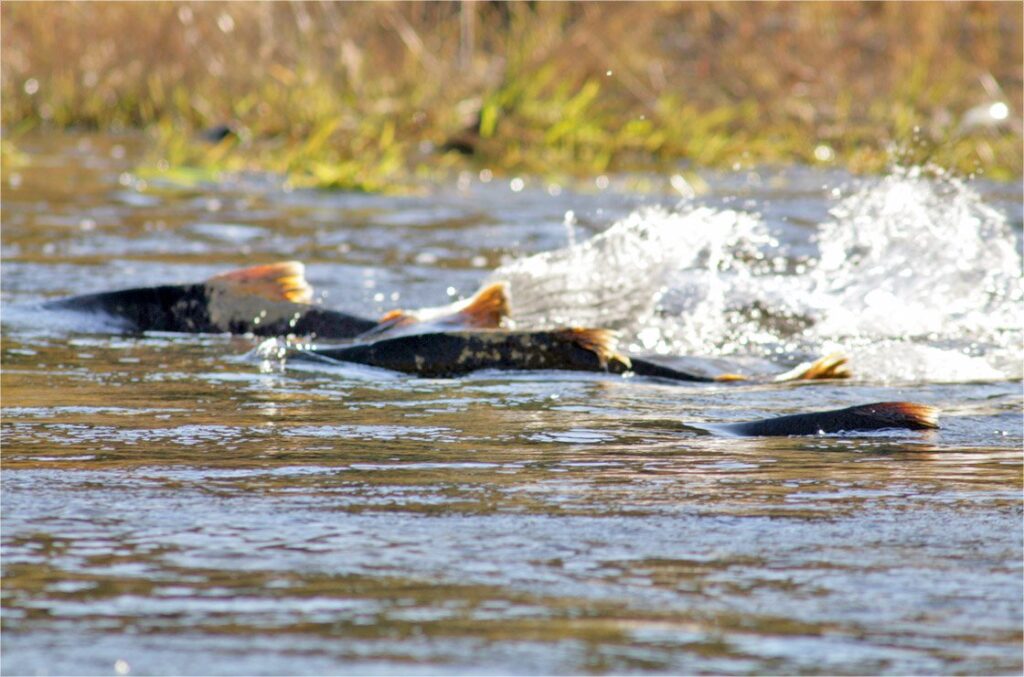By: NICK CAHILL
Via: https://www.courthousenews.com/data-confirms-salmon-slaughter-on-californias-main-river/
Nearly an entire run of juvenile winter-run Chinook salmon cooked in the Sacramento River this past summer, casting doubt as to whether the iconic species can survive the one-two punch of drought and climate change.

SACRAMENTO, Calif. (CN) — State officials confirmed dire predictions of catastrophic fish kills due to sizzling water temperatures in California’s largest river, announcing Thursday that just 2% of winter-run Chinook juvenile salmon likely survived the summer.
The alarming percentage of juvenile salmon killed on the Sacramento River surpasses the scope of die-offs recorded in the state’s recent drought years and has officials sounding the alarm about the potential permanent collapse of the endangered species.
“The current drought situation is likely to produce very bad returns of fish 3-4 years from now and if we keep having these incredibly bad years, we will not dig out of our population decline,” said Chuck Bonham, director of the California Department of Fish and Wildlife. “We’ve got to accept that reality.”
As in previous drought years like 2014 and 2015, the federal government and state have been unable to keep water temperatures cool enough to sustain both eggs and juvenile salmon at several important rivers and streams. The lack of rain, record-breaking heat and deliveries of subsidized water to contractors during the drought have created a perilous situation for fish and wildlife.
According to data presented during a state Senate fisheries committee hearing Thursday, an estimated 75% of winter-run Chinook eggs essentially cooked this summer on the upper Sacramento River. Worse, experts believe nearly all the remaining salmon that did hatch soon died from a combination of low river flows and natural or human-caused mortality.
“It appears that only 1-2% of these endangered baby salmon survived just the first few months of their lives,” testified Doug Obegi, water division director at Natural Resources Defense Council.
For comparison, an estimated 3% of Sacramento River winter-run Chinook juveniles survived in 2014 and just 5% in 2015, both of which were also extreme drought years.
The lack of salmon able to return to spawn and replenish the population will again have significant impacts on the state’s commercial fishing industry down the road.
To account for the disastrous summer on the Sacramento and other rivers like the Klamath and Feather, fishing groups want the state and feds to ramp up fish hatchery operations that prevented the total collapse of salmon populations during the last drought.
The head of the Golden State Salmon Association said the recent trucking of fish from hatcheries directly to the ocean have proven successful. He also urged the state to try and revive salmon populations by planting in the upper reaches of rivers that have long been inaccessible to fish due to dams.
“The McCloud River and certainly spots on Butte Creek, the Feather River and Yuba River that all would invite that type of action, that sounds good to us, and we would love to participate,” said the association’s president John McManus.
Already in 2021 the California Department of Fish and Wildlife has been going to great lengths to combat the drought.
The lack of water in the state’s main reservoirs and subsequent low river flows forced the department to truck 17 million hatchery reared salmon directly to the ocean earlier this year. Conservation officials have also rescued fish from stagnant pools in stretches of rivers near the Oregon border where flows slowed to a trickle.
